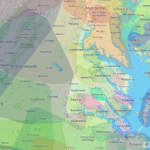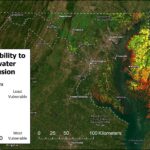The Climate Resilience Network’s very own undergraduate interns, Maria Stepanyan and Amira Tlemsani, shared their research on the impacts of tidal flooding on the city’s wastewater system with the Crisfield, Maryland Mayor Darlene Taylor. Mentored by Michael Maddox of ESSIC, CRN, and Hydronet, Maria and Amira presented their report “Crisfield Wastewater Overflow and Tidal Flooding Preliminary Study,” which details how meteorological variables influence tides and contribute to coastal flooding, wastewater system overflows, and public health concerns.
Crisfield is a low-lying city on Maryland’s southeastern Chesapeake Bay coast and has been heavily impacted by the relatively rapid sea-level rise in the Mid-Atlantic region and across the globe. Crisfield’s flooding is driven by astronomical tides and weather conditions. Astronomical tides follow predictable patterns, but weather conditions are less predictable and change day to day. The goal of this project was to identify how weather conditions influence tides and contribute to coastal flooding, wastewater system overflow, and public health concerns, ultimately to develop mitigation strategies and improve predictions of flooding events.

Environmental data, like tidal water level, obtained from NOAA tide gauge stations in nearby locations around Crisfield. Meteorological data was retrieved from the Iowa State University Environmental Mesonet from 4 regional weather stations near Crisfield. They reviewed wastewater violations from the National Pollutant Discharge Elimination System, and bacterial contamination levels from the BEACON EPA platform.
Using Python to process and analyze tide and meteorological data, they found that wind speed is the strongest and most consistent driver of abnormal high tides linked to wastewater overflows in Crisfield. Higher wind speeds were associated with greater water level anomalies (WLA), while temperature showed a negative relationship, and precipitation effects were inconsistent. Southwestern winds (180–270 degrees), particularly between 196 and 255 degrees, had the strongest influence, with certain combinations of high wind speed and direction raising water levels by more than three feet, conditions that almost certainly trigger flooding and wastewater overflows. They also found that elevated 10-day tidal anomalies were significantly associated with higher enterococcus levels at Wellington Beach, identifying sustained anomalies over this period as a strong predictor of bacterial contamination.
Mayor Taylor was highly supportive of this work and pledged to help support further research into this effort.
“Having the chance to share my findings directly with the mayor not only gave me practical insight into how to present research in a professional setting, adapt my communication for stakeholders, and understand the role of data-driven work in informing policy, but also made me realize that my work and research is truly valuable to this community,” says Maria Stepanyan, who is majoring in Public Health and Management and will continue to work with CRN in the fall.
“Overall, this experience provided me with valuable skills in data science, statistical analysis, and visualization, while also showing me how local environmental data can guide practical solutions for vulnerable coastal communities,” says Amira Tlemsani, a Geospatial Data Science and Information Sciences major planning to graduate in 2027.






